Market
Want to Dip a Toe Into the Blazing Market for Picasso? We Polled the Experts About Where the Smart Buys Are
Demand has seldom been higher, but there are plenty of hidden gems to be scooped up at lower price points.
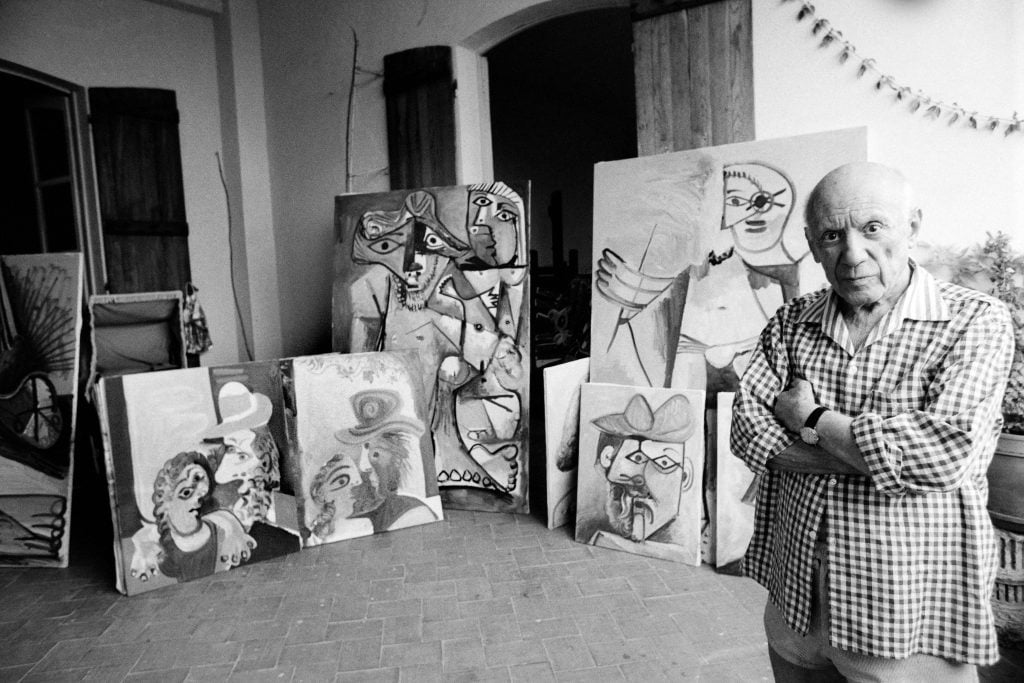
Demand has seldom been higher, but there are plenty of hidden gems to be scooped up at lower price points.

Eileen Kinsella

It’s hard to conceive of a more towering figure in art history than Pablo Picasso, the Spanish-born artist who is being celebrated via dozens of high-profile anniversary shows this year, to mark the 50th anniversary of his death.
His status as a household name in the 20th-century art canon reverberates strongly in the art market, where Picasso is among the most expensive artists of all time; the record for his work is $179 million for the 1955 Les femmes d’Alger (Version ‘O’), which sold at Christie’s New York in 2015. But even the lowest price for the top 100 works by the artist sold at auction is a whopping $17 million, according to the Artnet Price Database.
In 2021 alone, a peak year for auctions, sales of Picasso’s paintings reached nearly $532 million for just 60 works sold, an average of about $8.8 million per work. In ravenous bidding wars, art collectors compete for his signature canvases, hoping to nab a piece of the Picasso legacy, which is notably wide-ranging: from bold, Cubist-style imagery depicting harlequins to his melancholic blue-period characters or depictions of muses, mythological creatures, and musketeers.
At the same time, the ever-increasing spotlight on the artist over the decades has meant that curators and scholars continue mining his oeuvre for lesser-known bodies of work that still merit serious study.

Art handlers with Picasso’s Femme dans un rocking-chair (Jacqueline). Photo: Wiktor Szymanowicz/Future Publishing via Getty Images.
The drive to uncover new angles on the artist is strong. Last year the Hammer Museum organized a show focusing on Picasso’s lesser-known “cut papers,” intimate drawn cut-outs that he created from the age of nine, in 1890, all the way into his 80s. Other shows have delved into specific categories of work, such as his graphic pieces, while others compare his work in Cubism to the trompe l’oeil painting genre.
“When Picasso got involved in something, he did it until he felt he did everything he could with it,” said New York dealer John Szoke, who specializes in Picasso prints and works on paper. “He did it until he got it right.”
When it comes to to Picasso’s market, the ongoing scholarly research has resulted in these more obscure gems, including his works on paper, ceramics, and prints, growing into coveted collectibles, surfacing at healthy price points. They are decidedly less costly, however, than the seven- and eight-figure paintings, selling instead for tens to hundreds of thousands.
Given the popularity of the artist and his prolificness, auction houses frequently organize dedicated sales. In Paris this June, for example, Bonhams will hold its third in a popular series of “Picassomania” sales. “The breadth of his work goes far beyond his paintings, and the ‘Picassomania’ sale showcases the full extent of his creative genius,” said Lucia Tro Santafe, head of prints and multiples at Bonhams, in a statement. Ceramics, prints, works on paper, and photographs will be on offer to mark the 50th anniversary of the artist’s death.
Meanwhile, Sotheby’s recent March prints sale saw a 100 percent sell-through rate for Picasso and a record price for the artist’s renowned Le Déjeuner sur l’herbe, d’après Manet, a single edition from a set of 50 dating to 1962, which sold for £228,600 ($285,000) against a high estimate of £100,000 ($125,000). The house’s dedicated Picasso ceramics auction will be open online this month from April 14 to 21.
Given the huge breadth of Picasso’s practice (and prices), we parsed three concrete areas of his work that are well worth exploring, with help from the experts.
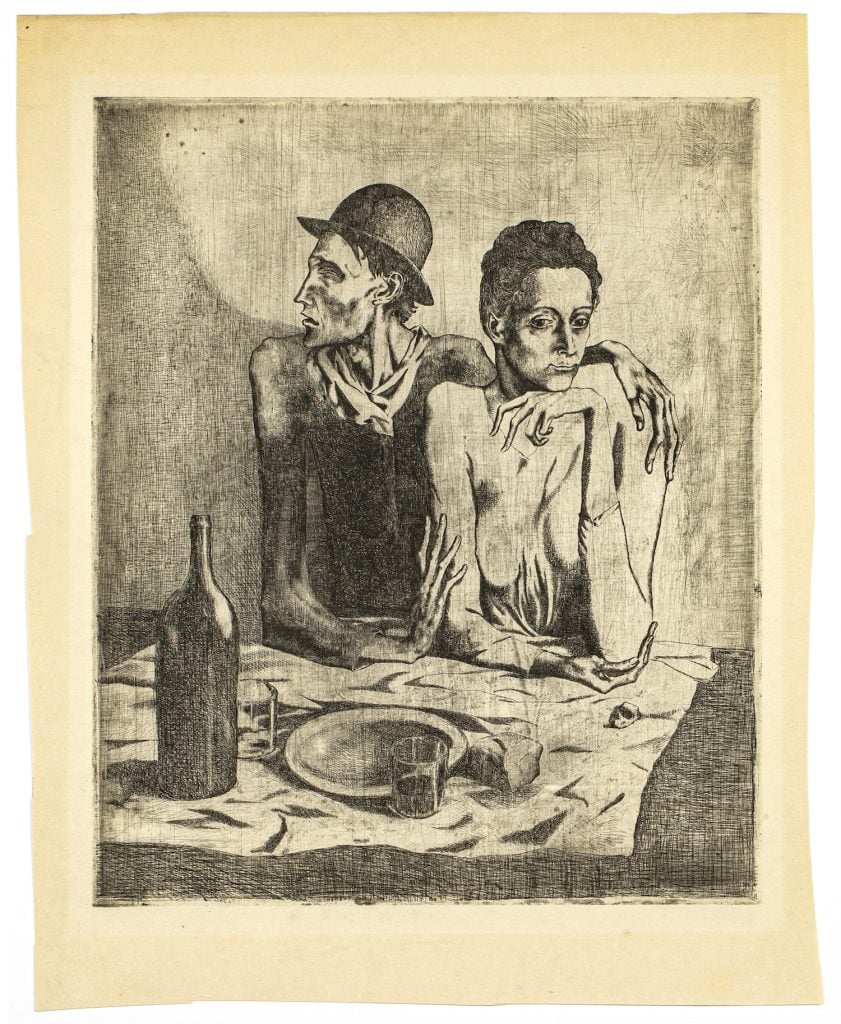
Pablo Picasso, Les Frugal Image courtesy John Szoke Gallery.
Some of Picasso’s most sought-after early print cycles include the “Vollard Suite,” named after his dealer Ambroise Vollard. Another is the “Saltimbanque Suite,” which includes one of the artist’s most famous prints, Le repas frugal (1904), depicting a man and woman at a near-empty dinner table. According to an essay by Christie’s specialist Murray Macauley, Picasso’s typical approach to prints saw him working intensively in a given technique for a period, during which he developed a close relationship with a particular printer, innovating new ways of working, before moving on.
Todd Weymann, vice president at Swann Auction Galleries, noted that for buyers in general, “There doesn’t seem to be a great deal of focus on the periods of his career.” Rather, he said what they seek “depends on imagery, it’s not so much date-driven.”
There is an emphasis on size and color, added Weymann. “The larger you get and the more colourful you get […] the more valuable [it is],” noted the specialist. “In the color realm, the low end is probably around $10,000 to $50,000. It’s very difficult to find anything in color by Picasso for below $10,000.”
Szoke, the dealer, has a personal collection that demonstrates how varied the price can be. He has an original print he purchased for $3,000 and one that is worth $6 million. “The range is enormous,” he said. “In my opinion, he’s the greatest printmaker since Rembrandt.”
Szoke advised interested buyers to trust their own instincts and taste. “If it hits you and it moves you, that’s for you,” he noted.
To that end, buyers have plenty of choices. The nearly 3,000 Picasso prints and multiples listed in the Artnet Price Database for 2022, range from the low five figures to the tens of thousands with most falling under $50,000.
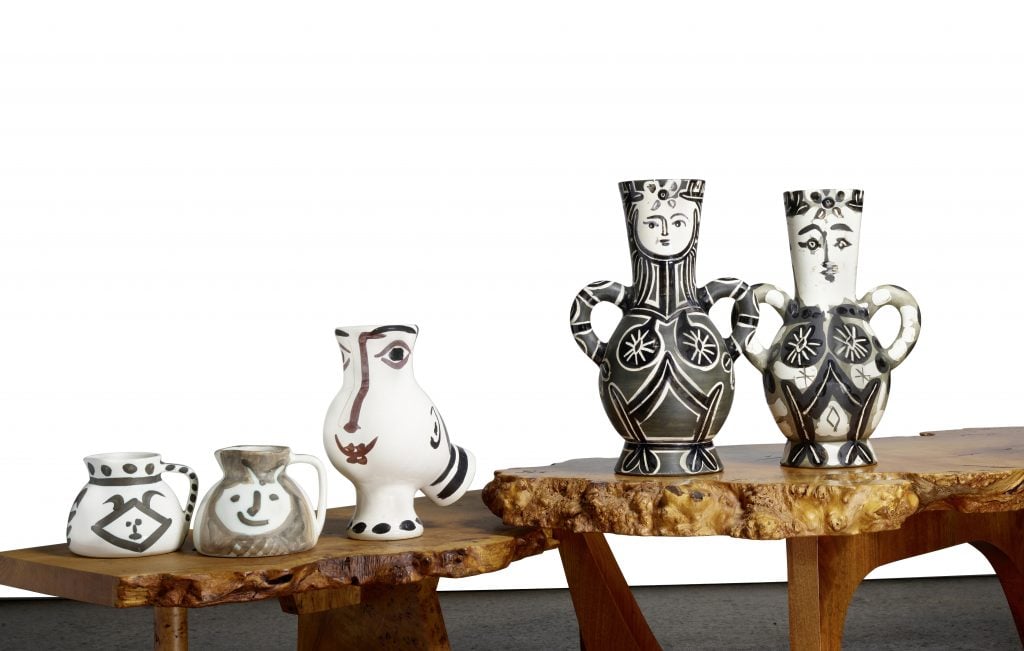
Picasso ceramics offered at Bonhams’s recent Los Angeles prints and multiples sale on March 28 included Vase with Two High Handles (Alain Ramié 213) (1953), second from right, which sold for $60,855. Courtesy of Bonhams.
The time that Picasso spent in the South of France had a profound effect on his artistic practice and it was how he discovered his passion for pottery, a medium that became integral to his working methodology from 1946 until his death in 1973.
During those years, he designed 633 different editions as well as unique works. According to Christie’s, the most common markings and stamps found on Picasso ceramics read “Madoura Plein Feu,” “Edition Picasso,” “Empreinte Originale de Picasso,” and “d’Après Picasso”—all of which indicate the piece is an authentic limited edition. (A spokesperson from Christie’s added: “Each of these is very useful for authentication purposes, although if in doubt, consult the experts.”)
“Picasso ceramics have been increasing in interest and growing in value over the years,” said Matthew Stavro, junior specialist in prints and multiples at Bonhams in New York. “It’s a great opportunity to own a work from the artist that is sculptural and colorful at an accessible price point.”
He noted that many of the artist’s ceramics are available for under $10,000 but that, like his prints, some that sell for much higher price points. A work to be featured in Bonhams’s upcoming May sale, a vase titled Visage au nez noir (1969), is estimated to sell for between $30,000 and $50,000. Last week, the house offered roughly three dozen Picasso editions in its Los Angeles sale, including ceramics that sold for prices ranging up to $60,855, for a black-and-white vase from 1953. In its upcoming prints and multiples sale, set for May 9, the house will offer 15 Picasso ceramics ranging in price from $2,000 to $50,000.
“This more coveted work is due to its popularity, ornateness, and larger scale,” noted Stavro. “Usually the more detailed ceramics with glazing achieve higher prices. People also tend to gravitate towards popular motifs such as [his second wife] Jacqueline [Roque] or the owl.”
Weymann concurred. “What I’ve seen really pick up in the last ten years or so is the ceramics,” he told Artnet News. “They’ve been the strongest of the what can be called the ‘Picasso edition market.’”
What should buyers expect in terms of pricing? “The higher the edition size and the smaller the object, the lower the value,” said Weymann. One can find a handful of ceramics, including small plates and bowls, going for around $3,000; prices move up into the $10,000 to $30,000 range for other forms, going into the $50,000 to $100,000 range for more complex shapes.
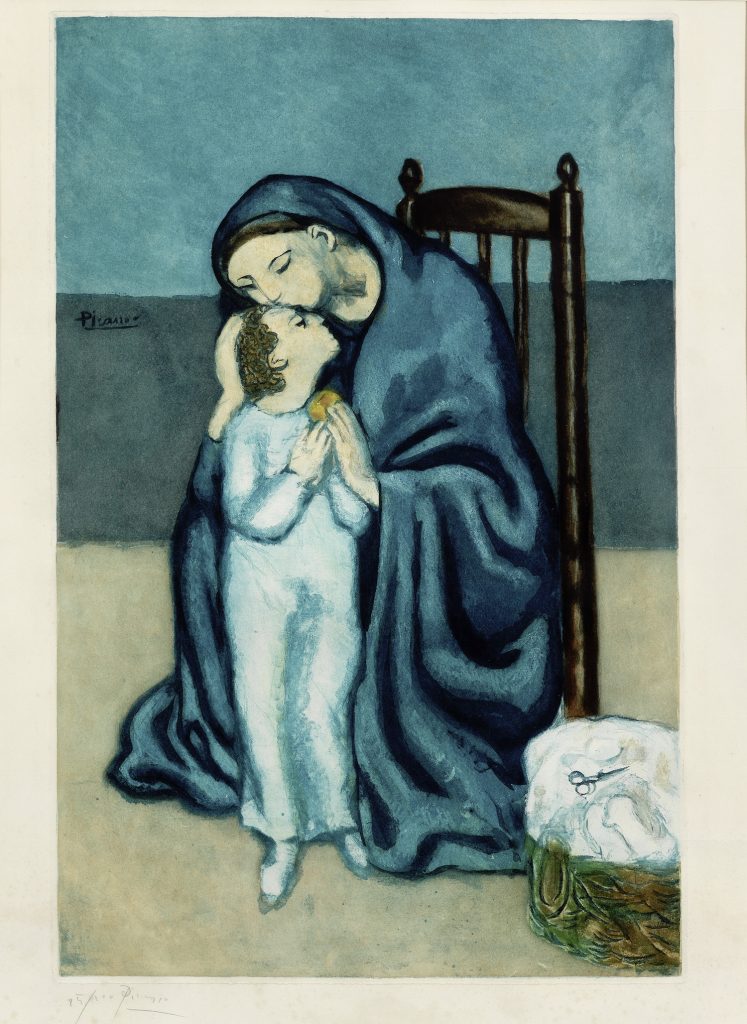
After Pablo Picasso by Jacques Villon, Maternité (Ginestet & Pouillon E670), etching and aquatint in colors (1930). Courtesy of Bonhams.
A lesser-known but solid market is an unusual hybrid category known as “after” works, meaning artworks that correlate to original prints made by Picasso.
Like several artists working in the 1910s and ’20s onwards—including Joan Miró, Marc Chagall, and Henri Matisse—Picasso collaborated with printmaking workshops that would “produce prints inspired by their famous works,” according to Weymann. Picasso allowed his trusted printmaker Jacques Villon (who was, incidentally, Marcel Duchamp’s brother) to create works inspired by Picasso’s own designs. These works were “authorized, signed, and numbered for the printmaking workshop, even though he didn’t create them with his hand,” said Weymann.
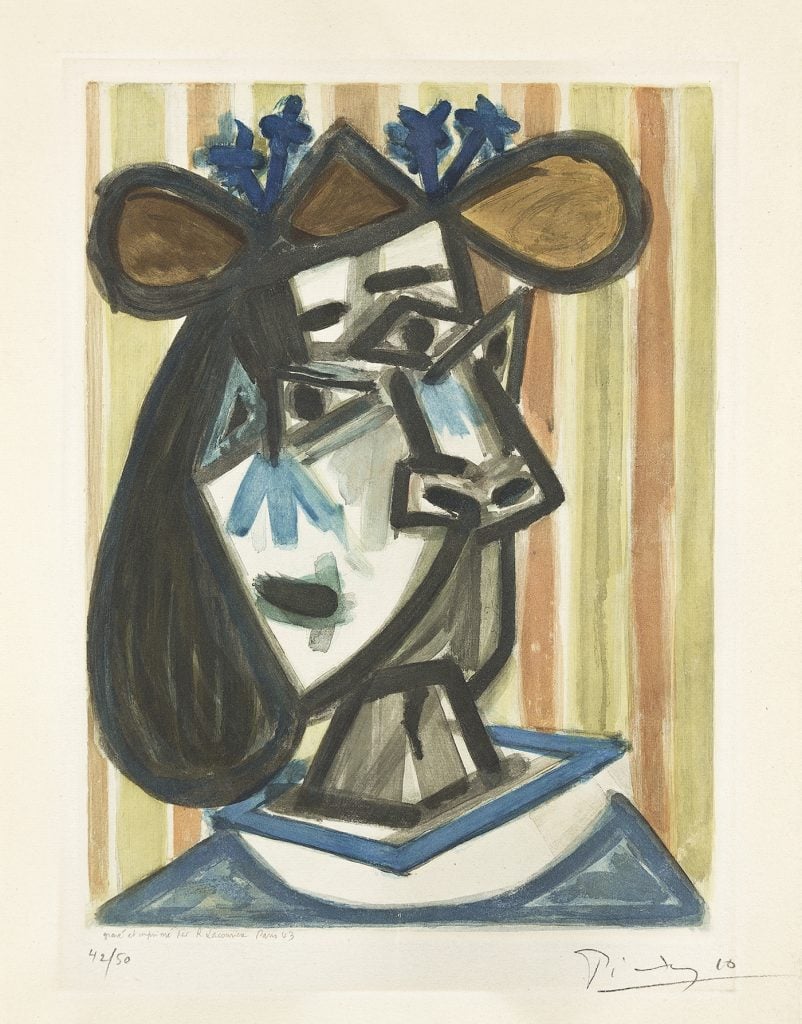
Pablo Picasso, Tête de Femme (Dora Maar), color aquatint, circa 1943. Sold at Swann in November 2022 for $25,000. Image courtesy Swann Galleries.
They now form a sizable market related to the artist that should not be ignored. For instance, a color etching and aquatint of Pablo Picasso’s Les Saltimbanques, etched by Villon after Picasso’s oil painting of the same name, was signed by both Picasso and Villon. It sold for $20,800 in 2020. Another work, called After Pablo Picasso, made by Villon in 1930, sold at Christie’s for $15,000 at an April 2012 sale, well above the $10,000 high estimate.
Stavro, of Bonhams, echoed the health of this area of the Picasso market. “We think it’s a great opportunity for collectors, since this is a more approachable price point for colorful prints,” he said, adding that the definition of “after” is often misunderstood. “It means the work started out as a different medium than the final result. It could have been a painting that was turned into a print, then signed by the artist.” In several cases, the term designates pieces that were printed by Villon and then signed by Picasso. “The ‘After’ prints tend to be more colorful than the etchings and lithograph which are typically monochrome,” added Stavro.
Making color prints is also a technically complex and expensive process. As a result, it was only when an artist like Picasso’s career was established that he was then able to collaborate with printmaking studios. “Most of the time, [artists making prints] went back to signature early works to ‘reproduce’ [them] in color,” said Stavro.
“After” Picasso works sell for anywhere from $10,000 to $30,000. Interestingly, due to color and size, as well as the iconic imagery, in many cases, the category can have more value than smaller monochrome prints made by Picasso himself, noted Stavro.